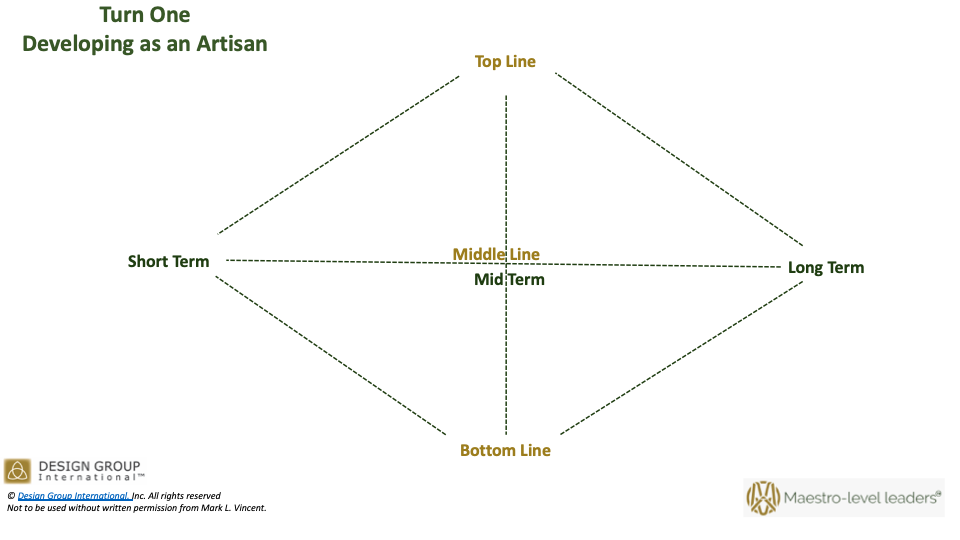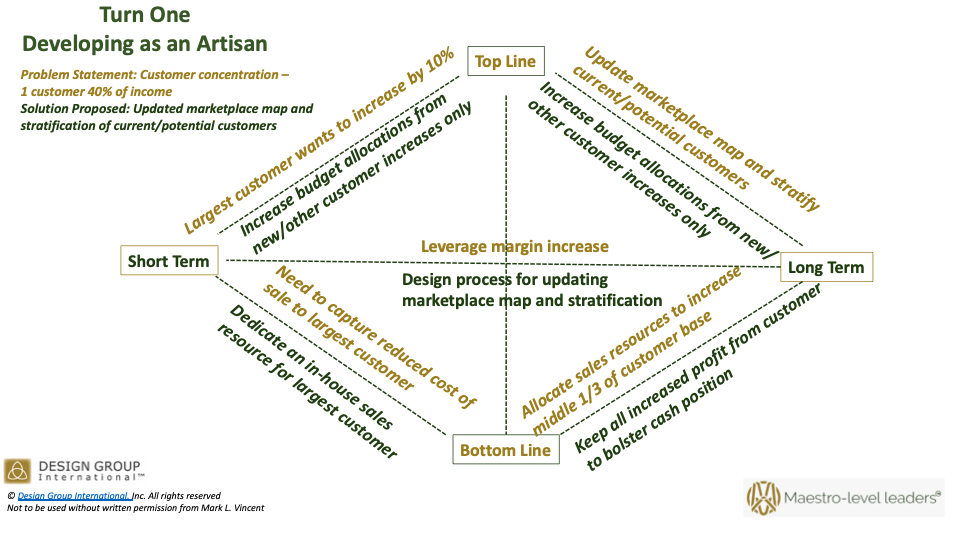
For those who are moving more deeply into Turn One Artisanship and aspire to C-Suite Artistry (Turn Two), this post is especially for you.
If you are already in the C-Suite, the tool in the diagram below is useful in developing executive leadership talent in your organization.
Time and Money

Time and money flow together; we are accountable for both, and a decision regarding one affects the other.
If money is time in a frozen form (result), then time is money in liquid form (opportunity).
If we monetize time, then we also need to chronologize money.
Money and time aren't completely identical, but they are not completely distinct and cannot be separated. When we mistakenly try to separate them -- as try we do -- we limit our ability to think and act.
It is good to hold Time and Money together and turn on all the lights so we can see what we are working with. This is especially important when forming or reporting on strategy and projecting or accounting for cost.
Many companies fail here because they strategize (time) and they budget (money), but they do so as separate or one-before-the-other processes. They end up fostering and reinforcing a culture of time and money as separate.
__________
Two Frustrations
By separating time and money, CEOs unconsciously set themselves up for two frustrations as they develop leaders and future value.
- Developing leaders bring them incomplete information without a solution.
- Developing leaders bring them incomplete information and incomplete solutions.
In the first case, the developing leader brings the problem and expects the CEO to identify the solution. This provides the astute CEO a coaching situation. They do well to say,"Thank you for bringing it to my attention. Do you have a solution in mind?" If the developing leader does not have a solution, the CEO then works with them to figure out how they will address the problem. Even more, the CEO will coach them to bring matters forward, having worked out how they would like to address it or with specific recommendations. Without the needed coaching and growth of the developing leader, the developing leader and the CEO become redundant, with neither doing their job.
If the CEO does not coach but rather gives in to being the problem solver, they reinforce and reward the habit of not leading. Even worse, some CEOs reprimand people for bringing problems to light without solutions rather than coaching and then rewarding for bringing the problem and the potential solution(s). When this happens, a third and disastrous frustration emerges -- (un)developing leaders bringing nothing forward and the CEO alienated from the information loop.
In the second case, the developing leader is being coached and empowered to identify solutions to problems. However, because the Time and Money divide remains in place, reports and proposals touch on money but not time, or time but not money. The problem description and proposed solutions either don't match the CEO's one-dimensional view or they match up with the CEO's limited perspective. Either way, neither the information and the solution are well examined, and both are incomplete.
__________
A Rubric that Helps

How do we address this problem and bring time and money back together?
Whatever we notice as a problem and whatever solution(s) we may suggest need to be defined and proposed according to the following:
Time:
- Long Term (more than 18 months, usually 3-5 years)
- Mid Term (more than one year, certainly beyond the current fiscal year)
- Short Term (within a year)
Money:
- Top Line (income)
- Middle Line (margin - difference between asset/liability, income/expense, or both)
- Bottom Line (profit)
Using this rubric, developing leaders and CEOs can have a common frame of reference for joint problem solving that touches on time and money.

We each default to either a time or a money orientation when faced with a problem to address. Within that orientation, we likely default to top, middle, or bottom line reporting and short, middle, or long-term planning. Developing Leaders and the CEO need to plot the definition of the problem or proposal together in light of these combinations. If they don't, they will not have developed organizational alignment. Alignment draws on everyone's expertise and creates a common perception of what the problem is and how it will be addressed. In short, everyone addressing this problem needs to contribute insight regarding all of these dimensions in order to make sure the issue is examined thoroughly and acted upon accordingly.
An example:

In the above example, the company is addressing a customer concentration problem.
- (short term and top line) Their largest customer represents 40% of business by volume and wants to increase another 10% in the next year. The company decides not to add this increase to its budgetary projection of expenses.
- (top line and long term) The company intends to update an overall map of the marketplace and to update their customer stratification in order to better target future customers and thereby dilute customer concentration.
- (long term and bottom line) The company expects it will end up allocating sales resources to its second tier (middle 1/3) of customers once the marketplace map and stratification of customers is updated.
- (short term and bottom line) The company intends to experience a lower cost basis for increasing sales to its largest customer in order to set cash aside and not be further dependent on its largest customer. It will do this by creating a dedicated in-house sales rep for this customer -- intending to raise value for the customer and also reduce company cost to do so.
- (mid term and middle line) The company intends to leverage the margin increase it experiences in order to attack the customer concentration problem. This will help to set aside the time and resource to map the marketplace and update the stratification of its customer base.
__________
Using the Rubric
There is no first or last part to fill in.
What matters is being thorough.
There is not necessarily an immediate or ready answer to every section.
What matters is being able to identify how you will arrive at answers.
There will likely be overlap among the sections.
What touches on more than one dimension likely reveals a critical path to follow.
Another company with the same problem will likely choose a different solution.
The method applied to a specific context is the outcome we seek when using this exercise.
The adept CEO who is developing future leaders under their watch teaches them to examine and think forward to a solution as thoroughly as possible, keeping both time and money in the same conversation while building alignment among all those who will carry it out.
Take this rubric into your executive suite and put it to use. After you've hit a few home runs with it, buy me a cup of coffee and regale me with the stories.
You can learn more about Maestro-level leaders and the supporting Third Turn Podcast by clicking on the links.
Tags:
Mark L. Vincent, Design Group International, Developing Leaders, Maestro-level Leaders, The Third Turn, time and money, organizational alignment
Post by
Mark L. Vincent
December 30, 2020
December 30, 2020
I walk alongside leaders, listening to understand their challenges, and helping them lead healthy organizations that flourish.
Comments